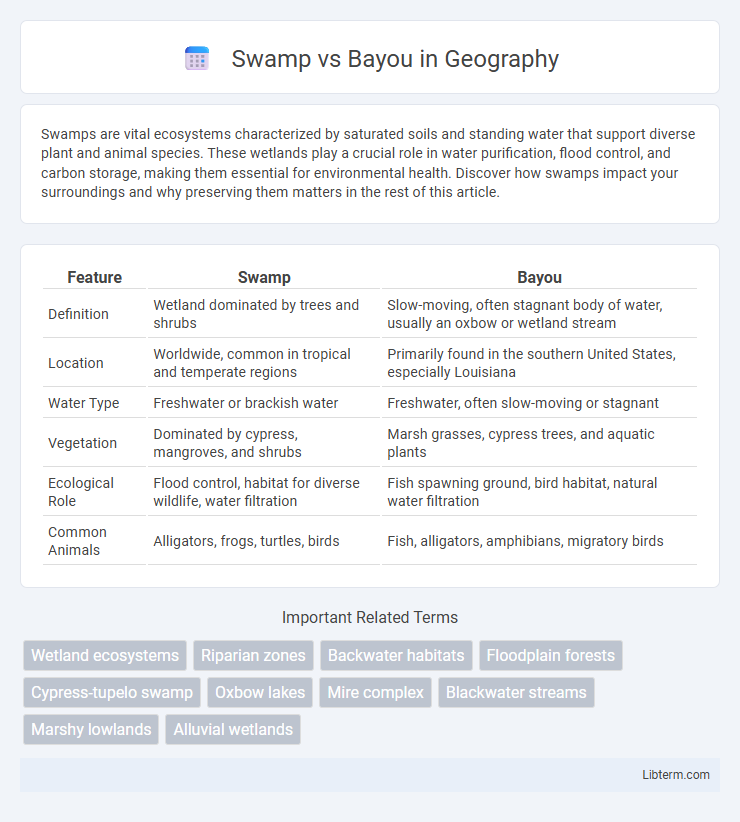Swamps are vital ecosystems characterized by saturated soils and standing water that support diverse plant and animal species. These wetlands play a crucial role in water purification, flood control, and carbon storage, making them essential for environmental health. Discover how swamps impact your surroundings and why preserving them matters in the rest of this article.
Table of Comparison
| Feature | Swamp | Bayou |
|---|---|---|
| Definition | Wetland dominated by trees and shrubs | Slow-moving, often stagnant body of water, usually an oxbow or wetland stream |
| Location | Worldwide, common in tropical and temperate regions | Primarily found in the southern United States, especially Louisiana |
| Water Type | Freshwater or brackish water | Freshwater, often slow-moving or stagnant |
| Vegetation | Dominated by cypress, mangroves, and shrubs | Marsh grasses, cypress trees, and aquatic plants |
| Ecological Role | Flood control, habitat for diverse wildlife, water filtration | Fish spawning ground, bird habitat, natural water filtration |
| Common Animals | Alligators, frogs, turtles, birds | Fish, alligators, amphibians, migratory birds |
Defining Swamps and Bayous
Swamps are wetlands dominated by woody plants, often featuring saturated soils and standing water that support diverse plant and animal life. Bayous are slow-moving, often marshy waterways commonly found in the southern United States, particularly Louisiana, characterized by shallow, brackish, or freshwater channels lined with cypress trees. While both are wetland ecosystems, swamps are primarily defined by their vegetation and saturated ground, whereas bayous emphasize flowing water and unique regional cultural associations.
Key Differences Between Swamp and Bayou
Swamps are forested wetlands dominated by hardwood or coniferous trees, often characterized by slow-moving or stagnant fresh water, whereas bayous are slow-moving, marshy waterways primarily found in the southeastern United States, especially Louisiana, featuring a mix of fresh and brackish water. Swamps typically have dense vegetation including cypress and tupelo trees, while bayous often contain a mix of water plants, grasses, and shrubs, reflecting their connection to larger river systems or coastal waters. The ecological roles differ as swamps serve as critical habitats for diverse wildlife and act as natural water filters, while bayous support unique aquatic ecosystems and are vital for local fisheries and cultural heritage.
Geographic Locations of Swamps and Bayous
Swamps predominantly occur in the southeastern United States, especially in states like Louisiana, Florida, and Georgia, where freshwater wetlands with dense trees thrive. Bayous are specifically found in low-lying, slow-moving water regions of the Gulf Coast, particularly in Louisiana and Texas, characterized by their marshy, sluggish streams or rivers. Both geographic formations are vital to regional ecosystems but differ by location and water flow, with swamps often inland and bayous closer to coastal areas.
Types of Vegetation in Swamps vs Bayous
Swamps typically feature dense vegetation dominated by hardwood trees such as cypress and tupelo, along with shrubs, ferns, and mosses adapted to saturated soils. In contrast, bayous are slow-moving water bodies lined with aquatic plants like water lilies, reeds, and grasses, alongside cypress trees with characteristic "knees" protruding from the water. The distinct plant communities in swamps promote diverse ecosystems, while bayous support rich aquatic habitats essential for fish and bird species.
Water Characteristics: Swamp vs Bayou
Swamps are freshwater wetlands characterized by slow-moving or stagnant water, often saturated with organic matter, creating oxygen-poor conditions that support dense vegetation like cypress trees and mangroves. Bayous typically refer to slow-moving or sluggish water bodies found in flat, low-lying areas, often with a higher salinity or brackish water mix, influenced by tides and supporting diverse aquatic life. The water in swamps tends to be more stagnant and nutrient-rich, while bayou waters are more dynamic with gradual flow and varying salinity levels due to tidal influences.
Wildlife Diversity in Swamps and Bayous
Swamps support a diverse range of wildlife including amphibians, reptiles, birds, and mammals adapted to standing freshwater habitats and dense vegetation like cypress and willow trees. Bayous, often slow-moving water bodies with brackish or freshwater, harbor unique species such as alligators, catfish, and various wading birds thriving in their marshy, nutrient-rich environment. Both ecosystems are critical for maintaining regional biodiversity, providing essential breeding grounds and food resources for numerous aquatic and terrestrial species.
Ecological Importance of Swamps and Bayous
Swamps and bayous serve as vital wetland ecosystems that support diverse wildlife, acting as natural water filters and carbon sinks. Swamps, characterized by saturated soils and woody vegetation, provide critical breeding habitats for amphibians, birds, and fish, helping maintain regional biodiversity. Bayous, slow-moving water bodies often found in flat, low-lying areas like the Gulf Coast, contribute to nutrient cycling and flood control by absorbing excess water and improving water quality.
Human Interaction and Usage
Swamps often serve as crucial sites for human activities such as fishing, timber harvesting, and wildlife observation due to their dense vegetation and diverse species. Bayous, commonly found in the southern United States, have historically supported local communities through transportation, fishing, and agriculture, particularly rice cultivation. Both environments require careful management to balance human use with conservation and flood control efforts.
Notable Swamps and Famous Bayous
Notable swamps include the Okefenokee Swamp in Georgia and Florida, known for its vast peat deposits and diverse wildlife, and the Great Dismal Swamp straddling Virginia and North Carolina, famous for its dense forests and historic significance. Famous bayous such as Louisiana's Bayou Teche and Bayou Lafourche are renowned for their slow-moving waters and rich cultural heritage tied to Cajun and Creole communities. These wetland areas serve crucial ecological roles, supporting unique ecosystems and offering recreational and educational opportunities.
Conservation Efforts and Environmental Threats
Swamps and bayous face significant environmental threats including pollution, habitat destruction, and invasive species, which disrupt their biodiversity and water quality. Conservation efforts focus on protecting these wetlands through habitat restoration, pollution control, and sustainable land use policies to preserve crucial ecosystems for wildlife and flood mitigation. Government agencies and environmental organizations prioritize wetland preservation to maintain ecological balance and support species that rely on these unique habitats.
Swamp Infographic

 libterm.com
libterm.com